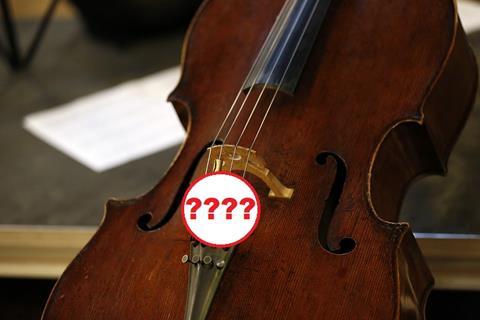Is it possible to combine different strings? In the first of two blog posts on the subject, Franz Klanner, director of engineering and technology at Thomastik-Infeld, shares his knowledge

COMBINING DIFFERENT STRINGS – IS IT EVEN POSSIBLE?
Each set of strings is developed in such a way that optimum results are ensured when it comes to sound and handling, as well as a maximum tonal life span for most instruments. The point of pitch stability and the tonal break-in time of all strings in a set are also ideally matched in order for them to achieve their best shape at the same time.
So why would anybody even consider combining strings from different product lines, manufacturers or groups of instruments instead of simply using a ready-assembled set of strings?
Every musician has their own individual conceptions. In order to be able to adjust the sound and handling to suit one’s own precise needs, one can combine strings from different product lines, meaning within the entire range of strings, but also even from different instrument groups.
WHAT ARE THE ADVANTAGES AND DISADVANTAGES OF COMBINING STRINGS?
The advantages are clear-cut: sound and handling can be adapted to fit individual needs, and the tonal balance and pressure requirements of the individual instrument can be taken into account.
However, combining strings can lead to a reduced tonal life span of the strings, and the point of pitch stability as well as the tonal break-in time of the individual strings may vary.
WHAT SHOULD GENERALLY BE TAKEN INTO ACCOUNT WHEN COMBINING STRINGS?
If one decides to combine strings from outside of the same product line, five factors should be borne in mind in order to ensure optimum results:
- the core material
- the string tension and height
- the winding material
- the diameter of the string (gauge)
- the point of pitch stability and tonal break-in time
1. THE CORE MATERIAL
Core materials can be mixed within a combined set of strings. That means that it is feasible, for example, to replace a synthetic core A-string with a steel core A-string.
Naturally, using different materials also leads to a change in the properties. Overall, the following attributes can be altered by the choice of different materials:
- the diameter (gauge)
- the pitch stability
- the feel under your fingers
- the bow and left hand response
Here are some examples of the effect this can have:
If a gold-coated stainless steel violin E-string is replaced by a tin-coated carbon steel E-string, the whistling of the gold E-string is usually reduced, but the susceptibility to corrosion is increased (string becomes coarse and discolored).
If a synthetic core violin or viola A-string is replaced by a chrome-steel-wound carbon steel core A-string, the response, pitch stability and corrosion resistance are usually improved, but the tonal and musical possibilities are limited. In addition, the diameter of a steel wire A-string is always much smaller. This results in the above-mentioned improved response, but the string also feels harder.
If a synthetic core viola D-string is replaced by a chrome-steel-wound carbon steel core D-string, the same applies as in the previous example. The diameter of the chrome-steel wire D-string is much smaller. The response, pitch stability and corrosion resistance are usually improved, but the tonal and musical possibilities are thus limited. What is more, the steel wire D-string also feels harder.
If a synthetic core viola C-string is replaced by a tungsten-wound spiral rope core C-string, the same thing happens. The diameter of the tungsten-wound spiral rope core C-string is considerably smaller. The response, pitch stability and corrosion resistance receive an upgrade; however, the tonal and musical possibilities are likely to suffer. Similarly, the steel wire C-string can sometimes feels harder.
In general, for violin and viola strings, a switch from synthetic core to steel strings leads to an increase in volume and a decrease in tonal and musical possibilities.
With cello strings, a spiral core is usually replaced with a steel wire core when it comes to A and D-strings. This results in an improvement in response and pitch stability. In contrast to this, for cello G and C-strings, a spiral rope core is usually used in order to optimize the flexibility, handling properties and tonal production possibilities.
With regard to double bass strings, it used to be less common to combine different core materials. But bassists that play both jazz and classical music are now increasingly using our Belcanto strings (rope core) for their G and D-strings, and our Spirocore with a light gauge (spiral core) for their A and E-strings. They thus achieve a growl and sustain on the lower strings, i.e. the prolonged rumbling that is useful for playing jazz, while the pure sound quality required for classical bowing techniques is achieved on the higher strings.

2. THE STRING TENSION AND ACTION
We have already comprehensively covered the importance of string tension in one of our previous articles (see blog post vibrating string length and string tension). If you have already found the ideal string tension for your instrument, you should definitely stick to it – not just overall, but actually per individual string.
If you do not yet know the ideal string tension for your instrument, the combining of different strings with varying string tensions provides a way to test this and thus reach the optimum outcome.
Don’t forget: beware of overloading and underloading! In this way, not only can the desired sound quality and ideal handling be achieved, but damage to the instrument is prevented. You can find all the details on this topic in the previous article vibrating string length and string tension.
Alongside the string tension, the action is also important for the sound and handling of the instrument. ‘Action’ is the distance from the string to the fingerboard.
Depending on the string tension, more or less force is required to press the string down onto the fingerboard. Generally speaking, instruments with a very small action (minimal distance between strings and fingerboard) require the use of strings with higher string tension, e.g. steel core strings, in order to achieve an ideal response and left hand as well as bowing feel (handling).
If strings with a low string tension are used on small-action instruments, the string touches the fingerboard too fast under the pressure of the fingers or the bow, and thus is prone to rattling.
However, caution is advised when selecting a string with higher string tension! This could have the effect of overloading the instrument. An alternative that is more beneficial and healthier for the instrument is to have the action adjusted by a luthier.
3. THE WINDING MATERIAL
Different winding materials also have an effect on the following properties:
- diameter
- bow response
- bow noise
- left hand (sliding) feel
- sound
- volume
We have put together a short overview of the three different winding materials and their effects:

4. THE DIAMETER
The diameter of the string affects the left hand feel and the bow response. As a general rule, thinner strings with the same outer winding material have a better response than strings with a larger diameter. Check out the list above!
5. THE POINT OF PITCH STABILITY AND TONAL BREAK-IN TIME
Sets of strings are put together not only on the basis of their tonal life span and properties, but also under the condition that they achieve their pitch stability and tonal development in as simultaneous a manner as possible. Therefore, if one combines strings from different families, it can take differing lengths of time until the individual strings have reached a stable pitch and have unfolded their full sound potential.
Both steel wire and steel rope core strings generally achieve pitch stability right away and thus much faster than other core materials (violin steel core E-string or viola steel core A-string). As a result, they can be easily combined with other strings when it comes to the point of pitch stability.
This is not to be confused with the tonal break-in time (= the time a string needs until all tonal colors have fully developed and the metallic sound component and background noise have disappeared), as this can take significantly longer with steel wire strings. This means that even if all 4 individually combined strings of different product lines have already reached pitch stability and can be played smoothly, they may still require varying amounts of time until all of them have reached their full sound potential.
In the second part of this blog post Franz Klanner will be focusing on the most common mistakes when combining strings and clarifies the question of how to safely combine strings from different manufacturers and even different instruments to achieve an ideal result.



































1 Readers' comment